headrest Hyundai Santa Fe 2005 Owner's Manual
[x] Cancel search | Manufacturer: HYUNDAI, Model Year: 2005, Model line: Santa Fe, Model: Hyundai Santa Fe 2005Pages: 277, PDF Size: 10.53 MB
Page 24 of 277
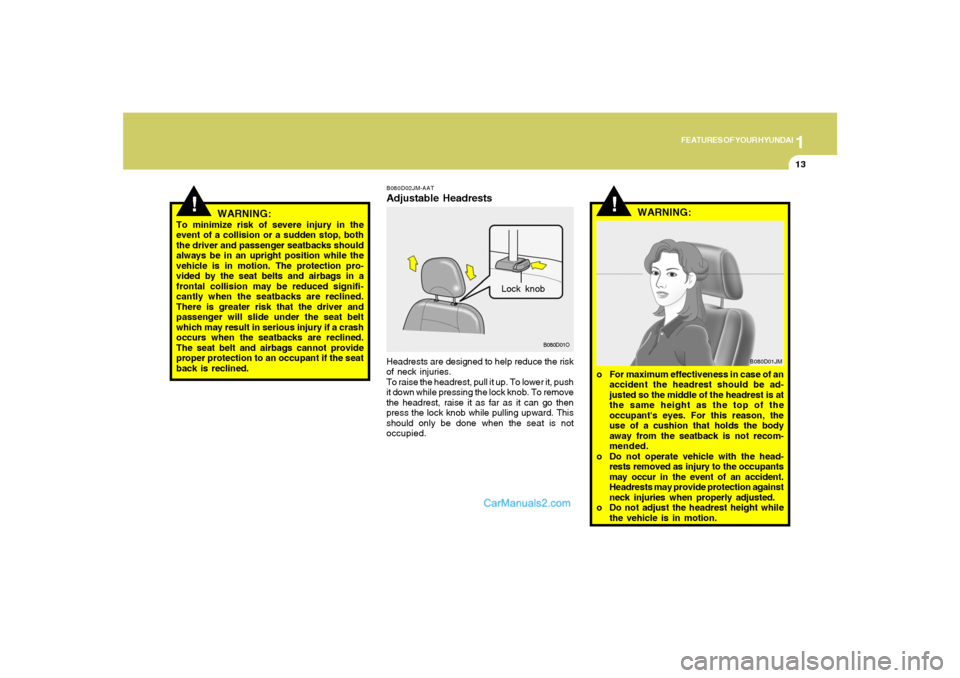
1
FEATURES OF YOUR HYUNDAI
13
!
WARNING:
To minimize risk of severe injury in the
event of a collision or a sudden stop, both
the driver and passenger seatbacks should
always be in an upright position while the
vehicle is in motion. The protection pro-
vided by the seat belts and airbags in a
frontal collision may be reduced signifi-
cantly when the seatbacks are reclined.
There is greater risk that the driver and
passenger will slide under the seat belt
which may result in serious injury if a crash
occurs when the seatbacks are reclined.
The seat belt and airbags cannot provide
proper protection to an occupant if the seat
back is reclined.
!
B080D02JM-AATAdjustable HeadrestsHeadrests are designed to help reduce the risk
of neck injuries.
To raise the headrest, pull it up. To lower it, push
it down while pressing the lock knob. To remove
the headrest, raise it as far as it can go then
press the lock knob while pulling upward. This
should only be done when the seat is not
occupied.
B080D01O
Lock knob
WARNING:
o For maximum effectiveness in case of an
accident the headrest should be ad-
justed so the middle of the headrest is at
the same height as the top of the
occupant's eyes. For this reason, the
use of a cushion that holds the body
away from the seatback is not recom-
mended.
o Do not operate vehicle with the head-
rests removed as injury to the occupants
may occur in the event of an accident.
Headrests may provide protection against
neck injuries when properly adjusted.
o Do not adjust the headrest height while
the vehicle is in motion.
B080D01JM
Page 28 of 277
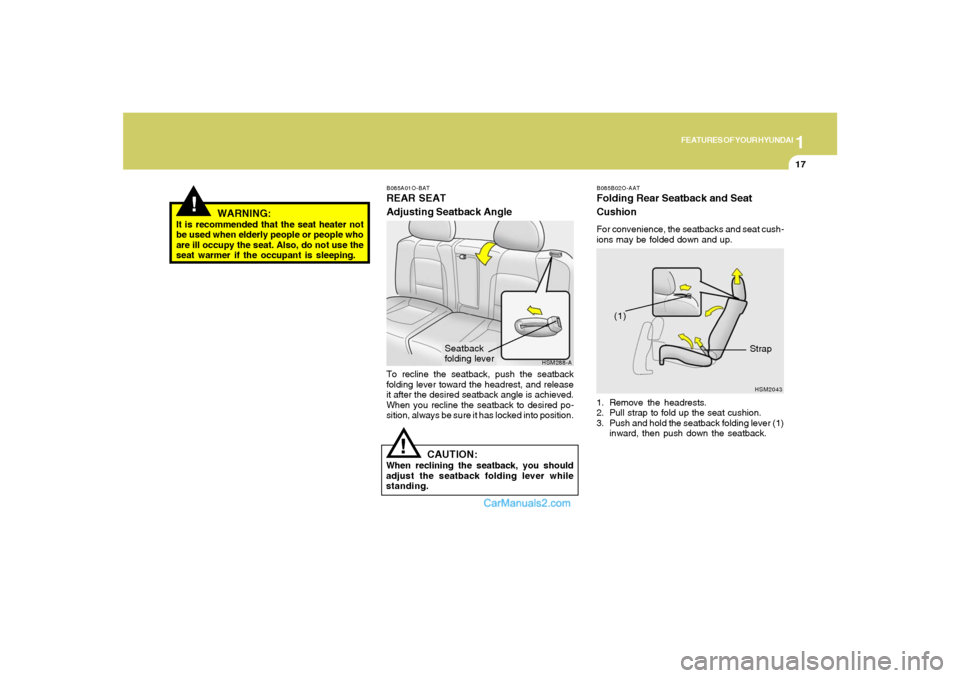
1
FEATURES OF YOUR HYUNDAI
17
!
B085A01O-BATREAR SEAT
Adjusting Seatback AngleTo recline the seatback, push the seatback
folding lever toward the headrest, and release
it after the desired seatback angle is achieved.
When you recline the seatback to desired po-
sition, always be sure it has locked into position.
CAUTION:
When reclining the seatback, you should
adjust the seatback folding lever while
standing.
HSM288-A
!
Seatback
folding lever
B085B02O-AATFolding Rear Seatback and Seat
CushionFor convenience, the seatbacks and seat cush-
ions may be folded down and up.
1. Remove the headrests.
2. Pull strap to fold up the seat cushion.
3. Push and hold the seatback folding lever (1)
inward, then push down the seatback.
HSM2043
(1)
Strap
WARNING:
It is recommended that the seat heater not
be used when elderly people or people who
are ill occupy the seat. Also, do not use the
seat warmer if the occupant is sleeping.
Page 29 of 277
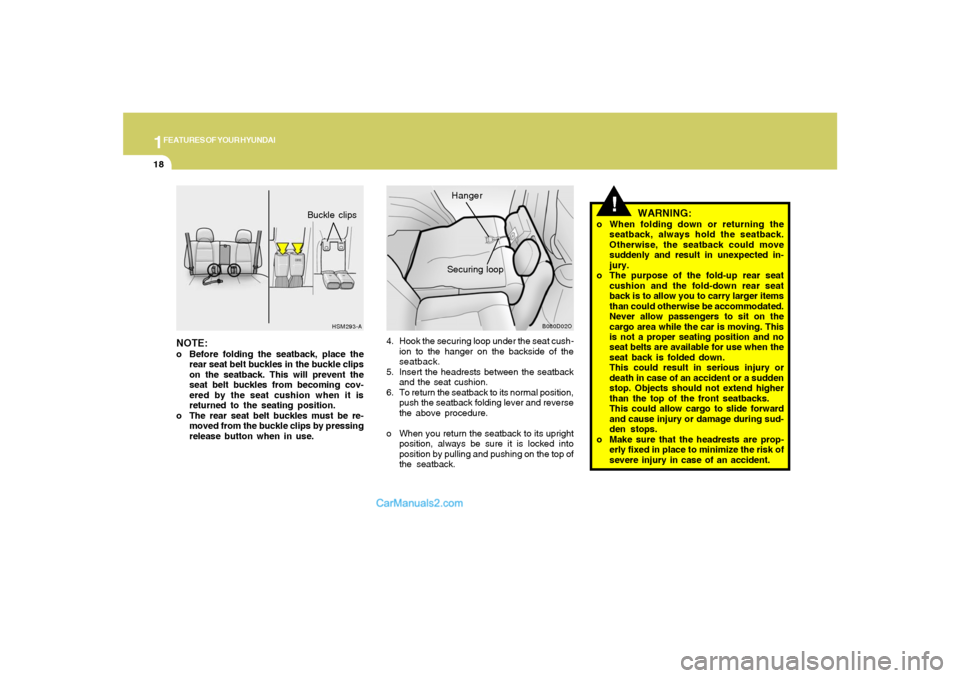
1FEATURES OF YOUR HYUNDAI18
WARNING:
o When folding down or returning the
seatback, always hold the seatback.
Otherwise, the seatback could move
suddenly and result in unexpected in-
jury.
o The purpose of the fold-up rear seat
cushion and the fold-down rear seat
back is to allow you to carry larger items
than could otherwise be accommodated.
Never allow passengers to sit on the
cargo area while the car is moving. This
is not a proper seating position and no
seat belts are available for use when the
seat back is folded down.
This could result in serious injury or
death in case of an accident or a sudden
stop. Objects should not extend higher
than the top of the front seatbacks.
This could allow cargo to slide forward
and cause injury or damage during sud-
den stops.
o Make sure that the headrests are prop-
erly fixed in place to minimize the risk of
severe injury in case of an accident.
!
4. Hook the securing loop under the seat cush-
ion to the hanger on the backside of the
seatback.
5. Insert the headrests between the seatback
and the seat cushion.
6. To return the seatback to its normal position,
push the seatback folding lever and reverse
the above procedure.
o When you return the seatback to its upright
position, always be sure it is locked into
position by pulling and pushing on the top of
the seatback.
B080D02O
HangerSecuring loop
NOTE:o Before folding the seatback, place the
rear seat belt buckles in the buckle clips
on the seatback. This will prevent the
seat belt buckles from becoming cov-
ered by the seat cushion when it is
returned to the seating position.
o The rear seat belt buckles must be re-
moved from the buckle clips by pressing
release button when in use.
HSM293-A
Buckle clips
Page 40 of 277
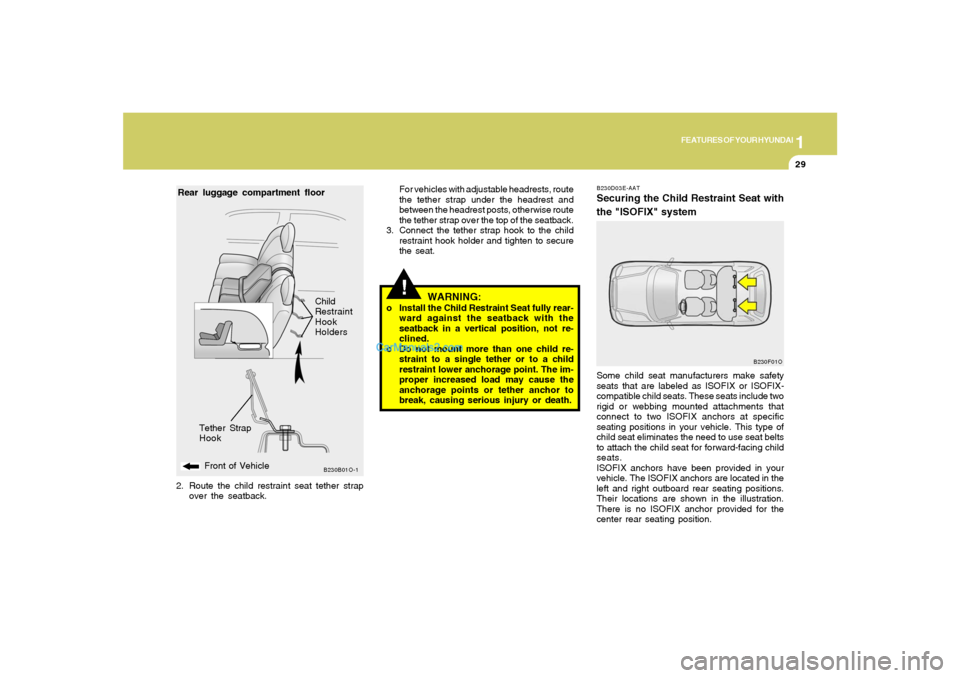
1
FEATURES OF YOUR HYUNDAI
29
!
B230D03E-AATSecuring the Child Restraint Seat with
the "ISOFIX" systemSome child seat manufacturers make safety
seats that are labeled as ISOFIX or ISOFIX-
compatible child seats. These seats include two
rigid or webbing mounted attachments that
connect to two ISOFIX anchors at specific
seating positions in your vehicle. This type of
child seat eliminates the need to use seat belts
to attach the child seat for forward-facing child
seats.
ISOFIX anchors have been provided in your
vehicle. The ISOFIX anchors are located in the
left and right outboard rear seating positions.
Their locations are shown in the illustration.
There is no ISOFIX anchor provided for the
center rear seating position.
B230F01O
For vehicles with adjustable headrests, route
the tether strap under the headrest and
between the headrest posts, otherwise route
the tether strap over the top of the seatback.
3. Connect the tether strap hook to the child
restraint hook holder and tighten to secure
the seat.
WARNING:
o Install the Child Restraint Seat fully rear-
ward against the seatback with the
seatback in a vertical position, not re-
clined.
o Do not mount more than one child re-
straint to a single tether or to a child
restraint lower anchorage point. The im-
proper increased load may cause the
anchorage points or tether anchor to
break, causing serious injury or death.
B230B01O-1
Front of VehicleTether Strap
HookChild
Restraint
Hook
Holders
Rear luggage compartment floor2. Route the child restraint seat tether strap
over the seatback.
Page 153 of 277
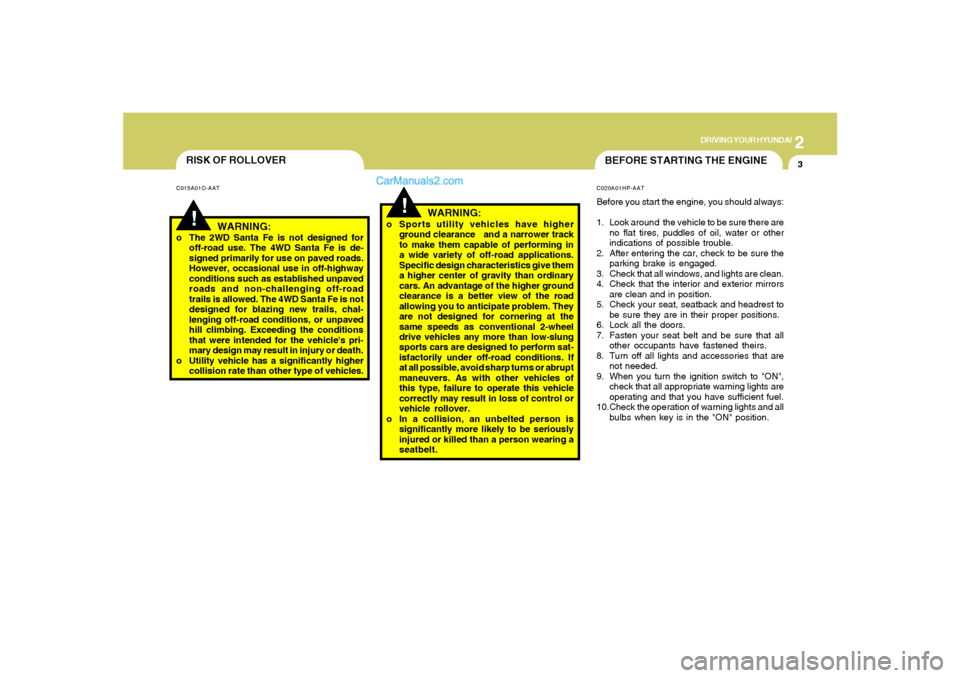
2
DRIVING YOUR HYUNDAI
3
RISK OF ROLLOVER
BEFORE STARTING THE ENGINE
!
!
WARNING:
o The 2WD Santa Fe is not designed for
off-road use. The 4WD Santa Fe is de-
signed primarily for use on paved roads.
However, occasional use in off-highway
conditions such as established unpaved
roads and non-challenging off-road
trails is allowed. The 4WD Santa Fe is not
designed for blazing new trails, chal-
lenging off-road conditions, or unpaved
hill climbing. Exceeding the conditions
that were intended for the vehicle's pri-
mary design may result in injury or death.
o Utility vehicle has a significantly higher
collision rate than other type of vehicles.
C020A01HP-AATBefore you start the engine, you should always:
1. Look around the vehicle to be sure there are
no flat tires, puddles of oil, water or other
indications of possible trouble.
2. After entering the car, check to be sure the
parking brake is engaged.
3. Check that all windows, and lights are clean.
4. Check that the interior and exterior mirrors
are clean and in position.
5. Check your seat, seatback and headrest to
be sure they are in their proper positions.
6. Lock all the doors.
7. Fasten your seat belt and be sure that all
other occupants have fastened theirs.
8. Turn off all lights and accessories that are
not needed.
9. When you turn the ignition switch to "ON",
check that all appropriate warning lights are
operating and that you have sufficient fuel.
10.Check the operation of warning lights and all
bulbs when key is in the "ON" position. o Sports utility vehicles have higher
ground clearance and a narrower track
to make them capable of performing in
a wide variety of off-road applications.
Specific design characteristics give them
a higher center of gravity than ordinary
cars. An advantage of the higher ground
clearance is a better view of the road
allowing you to anticipate problem. They
are not designed for cornering at the
same speeds as conventional 2-wheel
drive vehicles any more than low-slung
sports cars are designed to perform sat-
isfactorily under off-road conditions. If
at all possible, avoid sharp turns or abrupt
maneuvers. As with other vehicles of
this type, failure to operate this vehicle
correctly may result in loss of control or
vehicle rollover.
o In a collision, an unbelted person is
significantly more likely to be seriously
injured or killed than a person wearing a
seatbelt.
WARNING:
C015A01O-AAT
Page 272 of 277
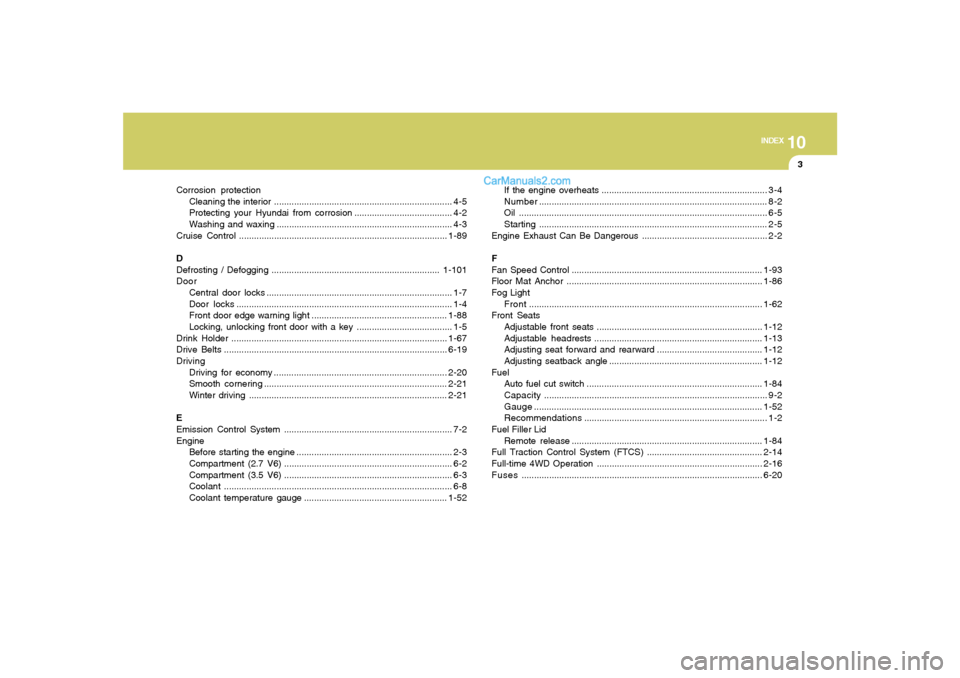
10
INDEX
3
Corrosion protection
Cleaning the interior....................................................................... 4-5
Protecting your Hyundai from corrosion....................................... 4-2
Washing and waxing...................................................................... 4-3
Cruise Control...................................................................................1-89
D
Defrosting / Defogging ...................................................................1-101
Door
Central door locks.......................................................................... 1-7
Door locks...................................................................................... 1-4
Front door edge warning light ......................................................1-88
Locking, unlocking front door with a key ...................................... 1-5
Drink Holder ......................................................................................1-67
Drive Belts.........................................................................................6-19
Driving
Driving for economy .....................................................................2-20
Smooth cornering.........................................................................2-21
Winter driving...............................................................................2-21
E
Emission Control System ................................................................... 7-2
Engine
Before starting the engine .............................................................. 2-3
Compartment (2.7 V6)................................................................... 6-2
Compartment (3.5 V6)................................................................... 6-3
Coolant........................................................................................... 6-8
Coolant temperature gauge .........................................................1-52If the engine overheats .................................................................. 3-4
Number........................................................................................... 8-2
Oil ................................................................................................... 6-5
Starting........................................................................................... 2-5
Engine Exhaust Can Be Dangerous .................................................. 2-2
F
Fan Speed Control............................................................................1-93
Floor Mat Anchor ..............................................................................1-86
Fog Light
Front.............................................................................................1-62
Front Seats
Adjustable front seats ..................................................................1-12
Adjustable headrests...................................................................1-13
Adjusting seat forward and rearward ..........................................1-12
Adjusting seatback angle .............................................................1-12
Fuel
Auto fuel cut switch ......................................................................1-84
Capacity......................................................................................... 9-2
Gauge...........................................................................................
1-52
Recommendations......................................................................... 1-2
Fuel Filler Lid
Remote release............................................................................1-84
Full Traction Control System (FTCS)..............................................2-14
Full-time 4WD Operation..................................................................2-16
Fuses ................................................................................................6-20